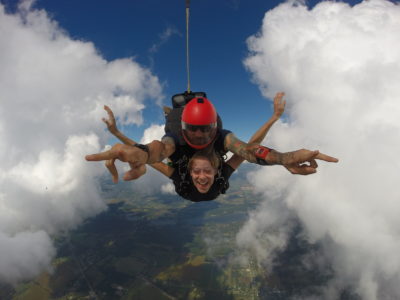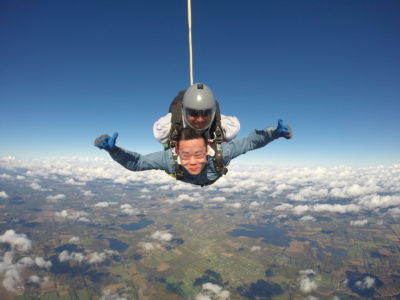- Michigan's Premier Skydiving Center
- Call Now: (517) 423-7720
Top Skydiving Hand Signals
Tuesday, October 31, 2023
- Skydive Tecumseh
- 10/31/23
- 0
- General
Are there hand signals all skydivers should know? Yes, and skydiving hand signals are universal! Let’s dive into what these are and why confidently using skydiving signals is critical for successful communication in the sky!
Why Are Hand Signals Used?
Are hand signals used because it is too loud to hear anything? Precisely! When we are in freefall, which is the portion of the skydive where hand signals are used, we’re falling over 100 mph. This means that the wind is FAST and LOUD, and unlike popular movies, skydivers cannot be heard in freefall.
Prioritizing safety above all else, skydivers rely on hand communication to mitigate risk. Hand signals allow skydivers to indicate a number of things, such as they’re leaving the formation and deploying their parachutes, responding to emergency situations, and navigating. Instructors heavily rely on hand signals to adjust student’s body positions and hone in on specific skill improvement.
The United States Parachute Association (USPA) lists 12 hand signals taught in skydiving. Let’s go over some of them, and learn about one useful unofficial one!
1. Thumb Down
What is the banana position in skydiving? The arch! The thumb down isn’t to say you’re doing a bad job, it’s simply saying to shove your pelvis downward and ensure a deeper arch. The arch is the most common and first-taught body position in skydiving. The pelvis is our center of gravity, and when this is foremost toward the earth, we are able to have stability in freefall. The arch is one of the first skills to master!
2. The Circle
 Make the “OK” signal with your thumb and index finger, now form a circle with the rest of your fingers to your thumb. This is called the “circle of awareness,” and is commonly used when instructors are teaching students. The circle of awareness indicates that the skydiver being given the signal needs to be aware of their bubble! This means they should check their altitude and acknowledge their peripheral vision to see if there are other skydivers around. The concept of the circle of awareness is used constantly on the skydive, but the hand signal is necessary for students to gain the habit.
Make the “OK” signal with your thumb and index finger, now form a circle with the rest of your fingers to your thumb. This is called the “circle of awareness,” and is commonly used when instructors are teaching students. The circle of awareness indicates that the skydiver being given the signal needs to be aware of their bubble! This means they should check their altitude and acknowledge their peripheral vision to see if there are other skydivers around. The concept of the circle of awareness is used constantly on the skydive, but the hand signal is necessary for students to gain the habit.
3. Peace Sign
This hand signal, with the pointer and middle finger extended to make a peace sign, lets the receiver know they need to straighten their legs. Skydivers’ fall rate and forward/backward movement are affected by their body position. In theory, straightening the legs will give the skydiver a forward drive.
4. Peace Sign (bent fingers)
This tells the recipient to bring their legs in or bend their knees. This will cause the skydiver to backslide, or back away from the formation.
5. Hang Loose
The “shaka sign” tells the skydiver to double-check their arm position. Just like the leg position, the arm position can cause a skydiver to turn or spin. If a student skydiver is unable to stop turning, it may be because one arm is slightly lower or higher than the other – they should typically be balanced.
6. Bent Wrist
Okay… think: The hands in the Thriller music video. We know, odd comparison. Bend your wrist and allow your hand to just hang out. This hand signal means RELAXXX! If a jumper seems a little tense or frustrated, they’ll be shown this signal. Skydivers famously live by, “Look good, have fun, safety third!” But in actuality we proudly put safety first, recognizing, of course, that having fun is important, too. Don’t get caught up and forget … you’re skydiving – weee!
7. Pointer Finger Extended
This may arguably be the most important hand signal – PULL! It simply means to pull your pilot chute and initiate the deployment of your parachute. It’s possible that the person giving the signal sees a reason why the other skydiver should deploy, or that the recipient lost altitude awareness and is past their predetermined pull altitude.
8. Thumbs Up!
 A thumbs-up means you’re doing a good job! GET IT!
A thumbs-up means you’re doing a good job! GET IT!
9. The “L”
An unofficial hand signal is the “L.” No, this doesn’t mean the person on the receiving end is a loser! Presenting an “L” means that the spot is long. If one skydiver looks towards the earth and notices the group is further from the landing area than anticipated, they may let the other jumpers know with a big “L.”
10. Wave Off
The wave-off signal is initiated when the skydiver is belly-to-earth (arching!) and is done by waving the arms and allowing the forearms to cross above the head.
Why Do Skydivers Give A Wave Off Signal?
The wave-off signal is more involved than a hand signal. What is the wave-off signal in skydiving, and why is it so important? The wave-off signal is used to let other jumpers know that you are about to deploy your parachute.
Imagine this scenario: A skydiver didn’t have a circle of awareness and ended up 10-20 feet above another jumper. The lower jumper does not wave off and deploys their parachute directly into the higher jumper – BIG OUCH for everyone. If the lower jumper takes a couple of seconds to wave off before initiating deployment, this allows time for the higher jumper to get outta there!
Although the higher jumper is technically at fault for not being aware enough and positioning above someone else, the lower jumper can counteract the higher jumper’s mistake by waving off. In this example, the wave-off will mitigate the chances of an entanglement and potential serious injury or death. Thank goodness for the good ol’ wave-off!
Are There Hand Signals You Definitely Should Not Make During Skydiving?
Pointing with your index finger unless it is pull time! In our American culture, it is common to say “Hey, look over there!” by using your pointer finger. But remember, the extended index finger means to deploy your parachute!
What Do You Write On Your Hands While Skydiving?
As a tandem student, you don’t have to worry one bit about hand signals, which frees your hands up for fun. You can write something on your palms for a nice photo op! “Hey / Mom!” “Free / Fallin'” and “No / Limits” are all solid choices.
The hand signal we’re using now is the “Come On Over!!!” wave! We can’t wait to have you for a tandem skydive, and once you discover the thrill (because we’re sure you will) we’re excited to train you to jump solo!

This was a great experience! The staff were friendly, the TI (Amber) was informative and made it fun. I felt very safe and in the care of a qualified and capable TI. Skydive Tecumseh has been around for over 50 years and I can see why. This is a fantastic place to check off one's bucket list, have fun with friends, and do something exhilarating. I highly recommend it for anyone who wants to have a chance of a lifetime.
Ellen Brothers
Copyright © 2024, Skydive Tecumseh, All Rights Reserved.
DropZone Web Design & Marketing by Beyond Marketing, LLC